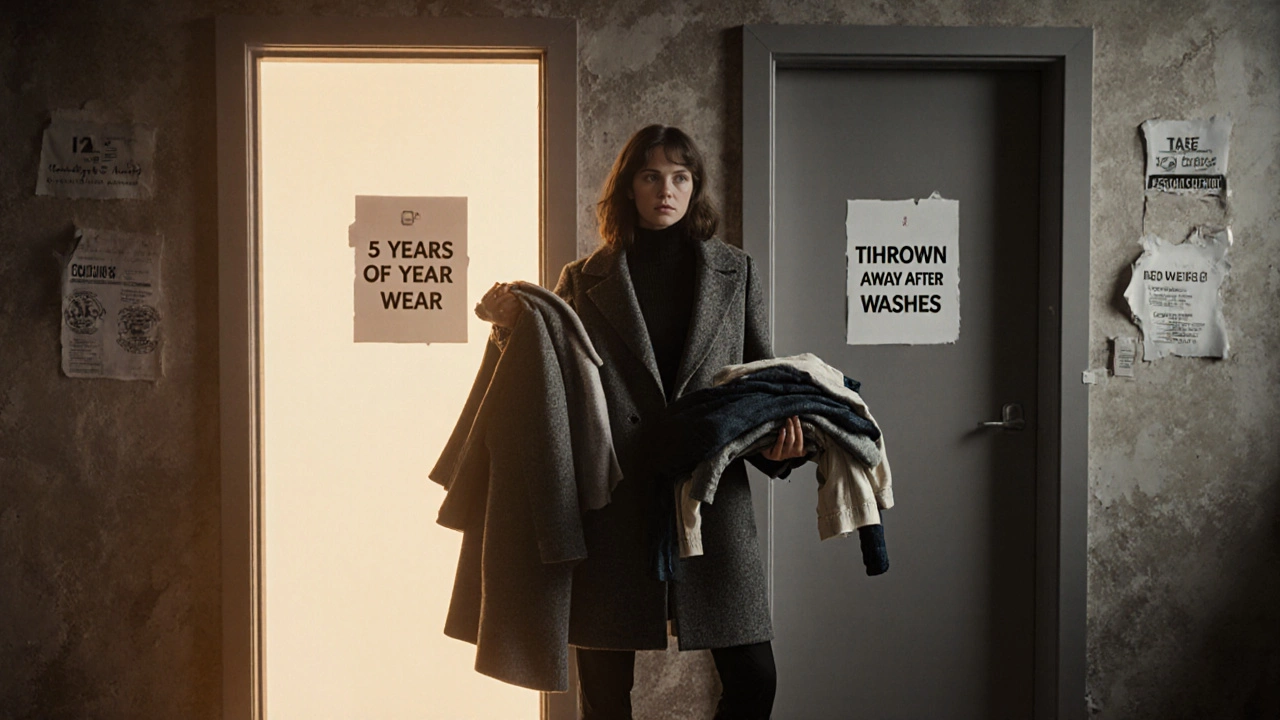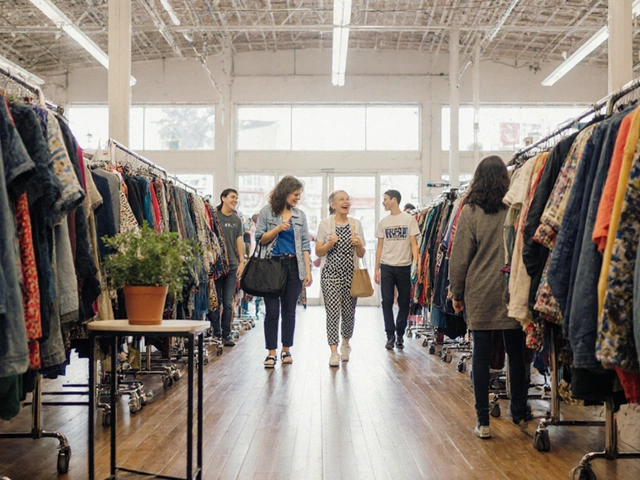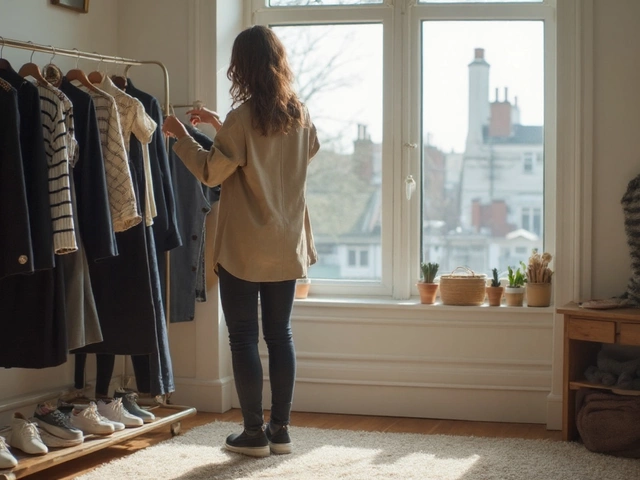Sustainable Fashion Brand Verifier
How Sustainable Is Your Brand?
Check if the brand meets key sustainability criteria from the article. Each "yes" counts as 1 point.
Ever bought a shirt labeled "eco-friendly" only to find out it was made in a factory with polluted water and paid workers less than $2 a day? You’re not alone. The word "sustainable" is everywhere in fashion right now-but most of the time, it’s just marketing noise. So how do you actually know if a brand is doing the right thing-or just pretending?
Look Beyond the Green Labels
A brand saying "sustainable" on its tag doesn’t mean anything on its own. Greenwashing is rampant. Brands slap on earth-tone packaging, use the word "organic" in their Instagram captions, and call it a day. But real sustainability isn’t a color or a buzzword. It’s a full system-from how fibers are grown, to how workers are treated, to what happens when you toss the garment.Start by asking: What materials are they using? If they claim to use "organic cotton," check if they’re certified by GOTS (Global Organic Textile Standard). That’s the gold standard. It means no synthetic pesticides, no toxic dyes, and fair labor practices all the way through. If they just say "organic" without certification, it’s a red flag.
Same goes for recycled materials. Many brands say they use "recycled polyester"-but where did it come from? Bottles? Old fishing nets? And how much of the garment is actually recycled? A jacket labeled "50% recycled" still has 50% virgin plastic. That’s not circular. It’s just less bad.
Check Their Supply Chain Transparency
If a brand won’t tell you where their clothes are made, they’re hiding something. Real sustainable brands map their supply chain. They name factories, not just countries. They list partners by name. You should be able to find the exact factory address on their website-or at least a photo of the workers and a story about their conditions.Look for brands that publish annual sustainability reports. Not glossy PDFs full of stock photos, but real data: water used per garment, carbon emissions per shipment, wage gaps between men and women in their factories. Patagonia, for example, publishes its full Footprint Chronicles. You can track exactly where your jacket came from and how much CO2 it took to make it.
If a brand says they’re "ethical" but won’t name their suppliers, they’re not transparent. And transparency is the first rule of real sustainability.
Ask About Labor Practices
Sustainability isn’t just about the planet. It’s about people. And too many brands treat workers as an afterthought.Ask: Are workers paid a living wage? Not minimum wage. Not the legal minimum in a country with weak labor laws-but enough to cover food, housing, healthcare, and education. The Fair Wear Foundation and the Textile Exchange both track this. Brands like People Tree and Eileen Fisher publish their wage data openly.
Look for certifications like Fair Trade Certified or B Corp. These aren’t cheap badges to buy. To become a B Corp, a company must meet high standards of social and environmental performance, accountability, and transparency. It takes years. And it’s renewed every three. If a brand says they’re "B Corp certified," verify it on the official B Lab website.
And don’t ignore gender equity. In garment factories, 80% of workers are women. Are they paid equally? Do they have access to childcare? Are they safe from harassment? These aren’t side issues. They’re core to sustainability.

How Long Do Their Clothes Last?
Fast fashion thrives on disposability. Sustainable fashion thrives on durability. A $10 t-shirt that falls apart after three washes isn’t sustainable-it’s wasteful.Real sustainable brands design for longevity. They use thicker fabrics, reinforced seams, and timeless cuts. They offer repair services. Everlane, for instance, has a repair program where you send back worn-out items and they fix them for a small fee. Some even sell replacement buttons or zippers.
Ask yourself: Would I keep this piece for five years? Would I wear it to a wedding, to work, and then on a weekend hike? If the answer is no, it’s not sustainable. Even if it’s made from organic cotton, if it’s designed to be thrown away after one season, it’s still part of the problem.
What Happens When You’re Done With It?
Most clothes end up in landfills. In New Zealand alone, over 100,000 tons of textiles go to waste every year. And synthetic fibers like polyester take 200 years to break down.Sustainable brands plan for the end of life. They offer take-back programs. They use mono-materials-like 100% cotton or 100% wool-so garments can actually be recycled. Brands like Eileen Fisher and Reformation collect old clothes and turn them into new ones. Some even use compostable packaging.
And here’s a simple test: If a brand doesn’t say what happens to your old clothes after you’re done with them, they’re not thinking about the full lifecycle. That’s not sustainability. That’s a sales tactic.
Compare Their Price to Their Claims
You can’t make ethically made, durable, low-impact clothing for $15. The math doesn’t add up. If a brand claims to use organic cotton, pay fair wages, and reduce carbon emissions-but sells a dress for $30-it’s either lying or cutting corners somewhere.Real sustainable brands cost more. That’s not because they’re greedy. It’s because they’re paying workers fairly, using better materials, and investing in cleaner production. A $120 wool coat that lasts 10 years costs less per wear than a $30 polyester coat that falls apart after two.
Think in terms of cost per wear. Divide the price by how many times you’ll likely wear it. If you wear it 50 times, a $100 item costs $2 per wear. A $20 item worn 5 times? That’s $4 per wear. Suddenly, the "expensive" one is the smarter buy.

Look for Independent Certifications, Not Self-Declared Claims
Don’t trust a brand’s own labels. Look for third-party certifications. Here’s what actually means something:- GOTS - For organic fibers and ethical processing
- Fair Trade Certified - For fair wages and safe working conditions
- B Corp - For overall social and environmental performance
- OEKO-TEX Standard 100 - For non-toxic dyes and finishes
- Bluesign - For low-impact textile manufacturing
These certifications require audits, inspections, and ongoing compliance. They’re not easy to get. If a brand has one or more of these, it’s a strong sign they’re serious.
Ignore labels like "green," "natural," "eco-conscious," or "planet-friendly." They’re not regulated. They mean nothing.
Watch for Overproduction and Slow Fashion
Even the most ethical brand can be unsustainable if they make too much. Overproduction is one of fashion’s biggest hidden sins. Brands create 10,000 units of a dress, sell 6,000, and burn the rest. Or dump them in developing countries, flooding local markets.Truly sustainable brands produce in small batches. They make what they know they’ll sell. They use pre-orders to avoid excess. They don’t chase trends. They focus on timeless pieces that don’t go out of style.
Ask: Do they have a "new arrivals" section updated every week? If yes, they’re still operating like fast fashion. Sustainable brands update slowly-maybe twice a year. They’re building a wardrobe, not a trend cycle.
Trust Your Gut-and Do the Math
There’s no perfect brand. But there are clear signs of real commitment. If a brand checks most of these boxes-certifications, transparency, fair wages, durability, end-of-life plans, and honest pricing-you can feel good about supporting them.Start small. Pick one item. Ask the questions. Look up the certifications. Compare prices. You don’t need to overhaul your whole closet overnight. Just make the next purchase count.
Sustainable fashion isn’t about being perfect. It’s about choosing better, one garment at a time.
Can a brand be sustainable if it’s not organic?
Yes. Organic materials help reduce pesticides and water use, but sustainability is about more than just fibers. A brand using recycled polyester, low-impact dyes, fair labor, and repairable designs can still be sustainable-even if it doesn’t use organic cotton. The key is looking at the full picture: materials, labor, emissions, and end-of-life.
Are secondhand clothes always more sustainable than new sustainable brands?
Generally, yes. Buying secondhand avoids the environmental cost of making something new. But if you’re buying new, supporting a truly transparent, certified sustainable brand is still a better choice than buying from fast fashion. The ideal? Buy secondhand when you can, and support ethical brands when you need something new.
Do sustainable brands ever use plastic packaging?
Some still do, but the best ones don’t. Look for brands using compostable mailers made from cornstarch, recycled paper, or even no packaging at all. If a brand still uses plastic bubble wrap or polybags, they’re not fully aligned with sustainability-even if their clothes are ethical. Packaging matters.
How can I verify if a brand’s sustainability claims are real?
Check their website for third-party certifications like GOTS, Fair Trade, or B Corp. Look for detailed reports on their impact-water usage, emissions, wages. Search for independent reviews from sites like Good On You or Fashion Revolution. If they can’t back up their claims with data, they’re probably greenwashing.
Is sustainable fashion only for rich people?
It doesn’t have to be. While some sustainable brands are expensive, there are affordable options: buy less, choose well, and prioritize secondhand. Look for local thrift stores, clothing swaps, or brands like Pact or Thought that offer quality basics under $50. Sustainability is about making smarter choices, not spending more.
Start by checking one brand you already buy from. Look at their website. Ask yourself: Do they name their factories? Do they pay fair wages? Do they fix your clothes? If you can’t find answers, it’s time to look elsewhere. You don’t need to be an expert. You just need to ask the right questions.








